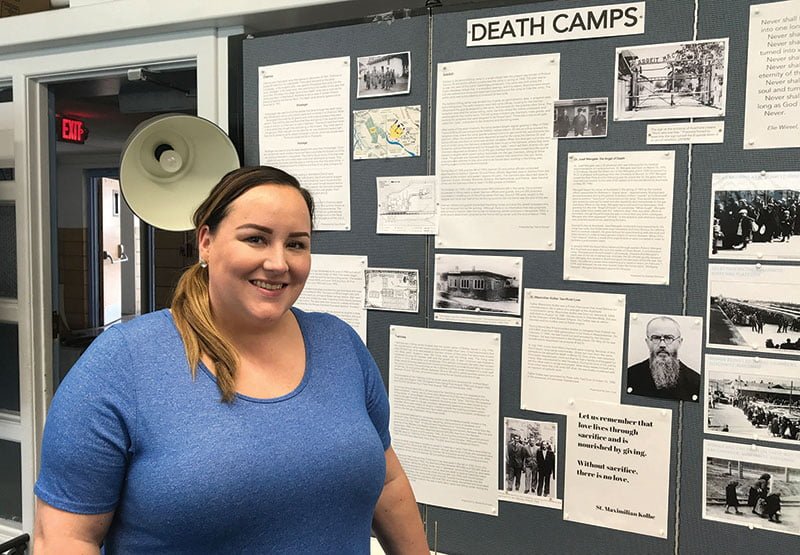
Megan Fairchild, a middle school English language arts teacher at St. John the Evangelist School in Lawrence, stands in front of a display at the school’s “A Night of Remembrance: A Holocaust Exhibit.” The exhibit includes student’s research, writing and artwork. LEAVEN PHOTO BY STEVE BUCKNER
by Steve Buckner
Special to The Leaven
LAWRENCE — Never underestimate the power and influence of a good book.
As a middle school student, Megan Fairchild read Elie Wiesel’s Holocaust memoir “Night.” The book resonated with her, and Fairchild, now a middle school English language arts teacher at St. John the Evangelist School in Lawrence, became interested in the Holocaust to the point that she now carries another title: U.S. Holocaust Memorial Museum Teacher Fellow.
Fairchild said it was the total breakdown in traditional norms of humanity that struck her most powerfully about the Holocaust — “the fact that it was human beings doing it to one another.”
“The psychological side of it is really interesting to me — how a person can get to that point where they would do that to one another,” she said.
Now in her fifth year at St. John School, Fairchild directs her eighth-grade students in a three-and-a-half- month unit on the Holocaust. The students’ reading, research, writing and artwork culminated on April 19 with “A Night of Remembrance: A Holocaust Exhibit” at the school.
Addie London, an eighth-grade student at St. John, said she learned a lot from the Holocaust study.
“I think just how long it took (1933-45), and how many countries did nothing even though it was evident that it was happening,” she said. “And, that you need to be kind to everyone.”
National distinction
Fairchild earned the distinction of Teacher Fellow in the summer of 2017. Earlier, she attended the prestigious Belfer Conference at the Holocaust Museum in Washington, D.C., before applying for the fellowship.
The four-day conference marked Fairchild’s first formal professional development in studying the Holocaust.
“Independently, I had read a lot of books and memoirs about the subject,” she said. “I had attended a few teacher trainings, but nothing was as in-depth as the Belfer Conference.”
At the conference, other educators who were Teacher Fellows led and presented Holocaust materials to Fairchild and her classmates. The Teacher Fellows inspired her and encouraged her to apply for a fellowship.
An extensive application process followed.
“You have to outline your Holocaust curriculum, and they wanted an in-depth look at one of the lessons you teach and how well it applies to the museum’s standards,” Fairchild said. “There are 10 guidelines for teaching the Holocaust. So, they wanted to know how the lesson followed the guidelines.”
She noted that the application process also included essay questions about books and materials that were relevant to the classroom and relevant to her as a teacher. Another essay question asked how the Holocaust is important still.
Finally, out of about 150 applicants, Fairchild was one of 19 people to be selected as a Teacher Fellow for the 2017-18 academic year.
“I was supposed to have five years’ teaching experience, but when I applied I only had four years’ experience. They accepted me anyway,” she said. “It’s a one-year fellowship, but it’s a lifetime involvement.”
After her selection, Fairchild attended a weeklong program that explored the museum more in-depth and talked about the museum’s mission and vision statements.
“We worked on creating an outreach project that achieved the museum’s mission,” she said. “We had to promise to come back within the year, create a project and implement it. We’ll return to the museum in July to debrief on it.”
Auschwitz up close
In June 2019, Fairchild will lead a group of former and current students (as well as some adults) to Eastern Europe on a 13-day tour of Holocaust sites.
The two biggest sites to be toured are the Auschwitz complex and the Dachau camp. The group will spend time in Germany, Austria, Poland and Czechoslovakia on the tour.
The tour is still open to people interested in the Holocaust. They can contact Fairchild by email at: Fchildm2@gmail.com for more details.
For her eighth-grade class, Fairchild said the students gained a historically accurate knowledge of the time period.
“We focused on decision-making and individual choices impacting others along with the dignity of human life,” she said. “Beyond the Holocaust, we studied contemporary genocide cases and the Syrian conflict. We talked a lot about refugees and the importance of providing for them.”
A total of 11 million people, or about the population of Ohio, died in the Holocaust.
“No one can fathom that number,” Fairchild said.
So, she personalized her teaching by using the book “Salvaged Pages,” a collection from teenage diarists affected by the Holocaust. Students were assigned one diarist, and they created a profile for that person.
“I think putting one name or face [to the Holocaust] was important to the students,” Fairchild said. “It’s all about the dignity of human life.”







What a wonderful article and young woman. This is one lucky school to have a young person so passionate about human dignity and to pass this on to future generations.
What a wonderful article and young woman. This is one lucky school to have a you g person so passionate about human dignity and to pass this on to future generations.